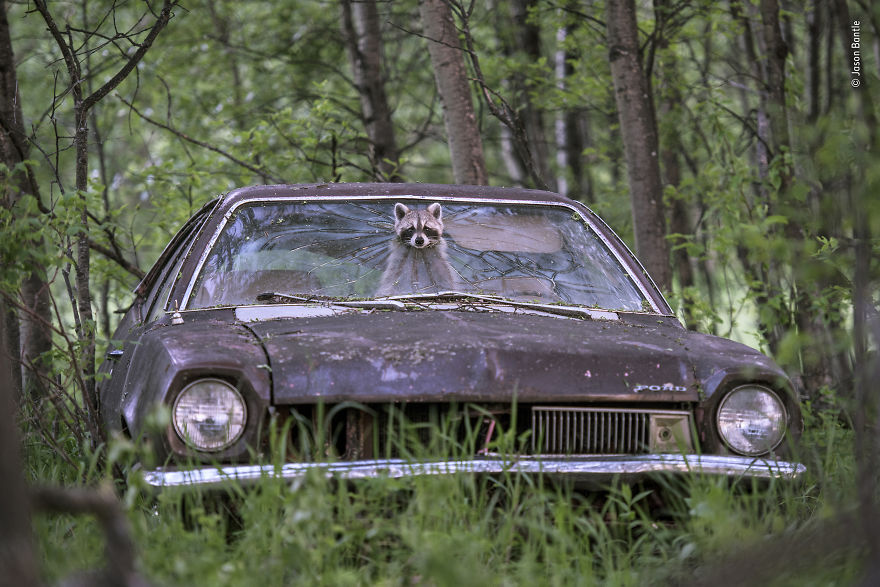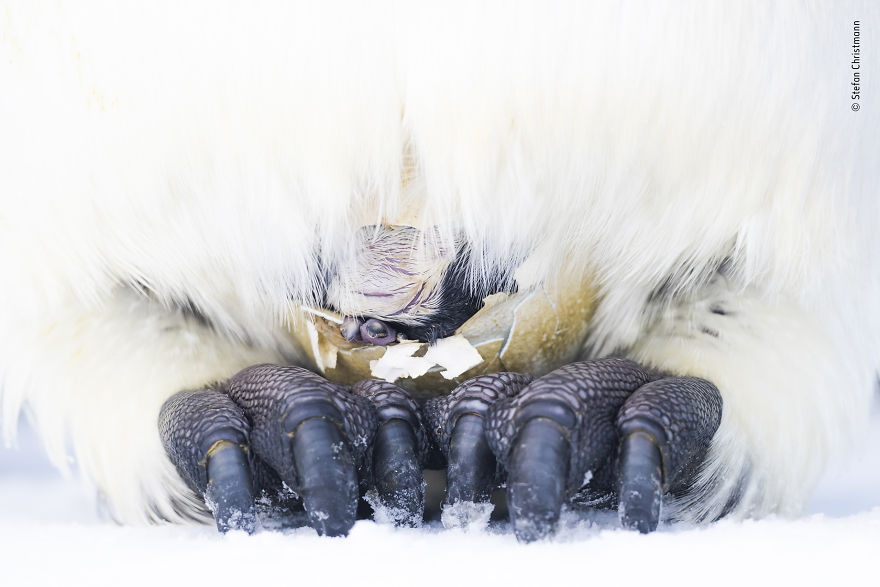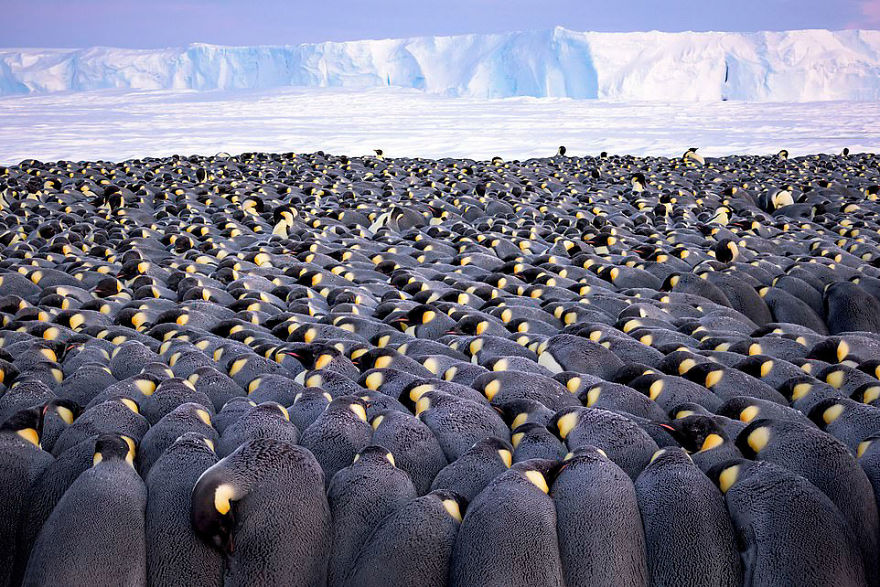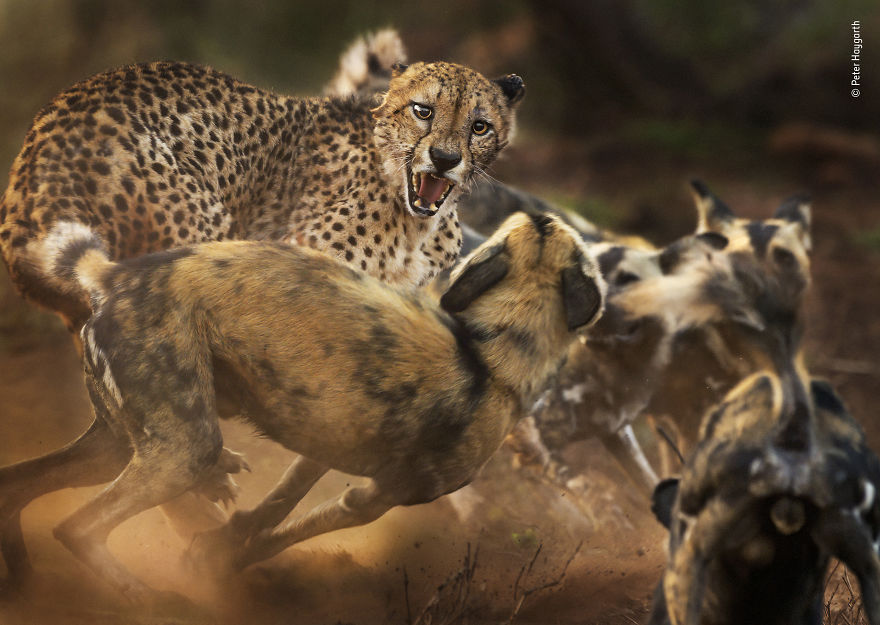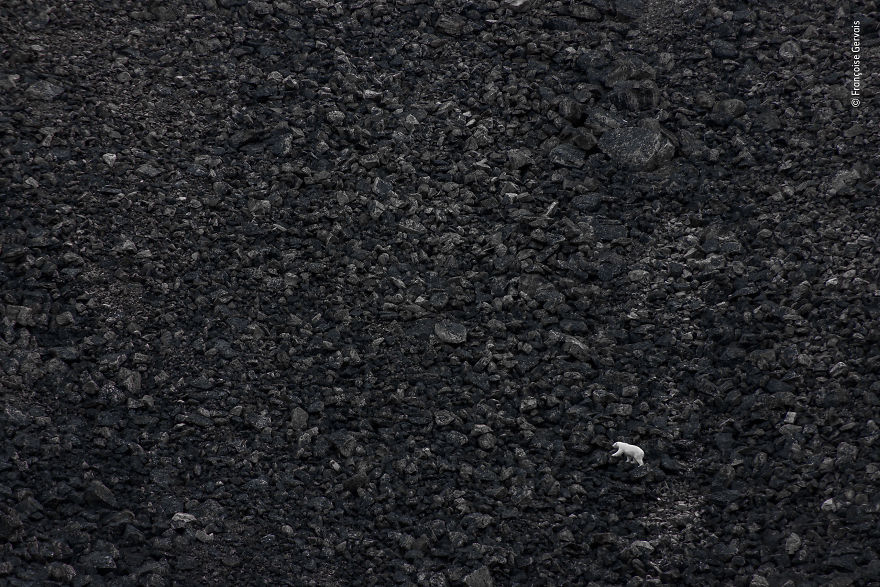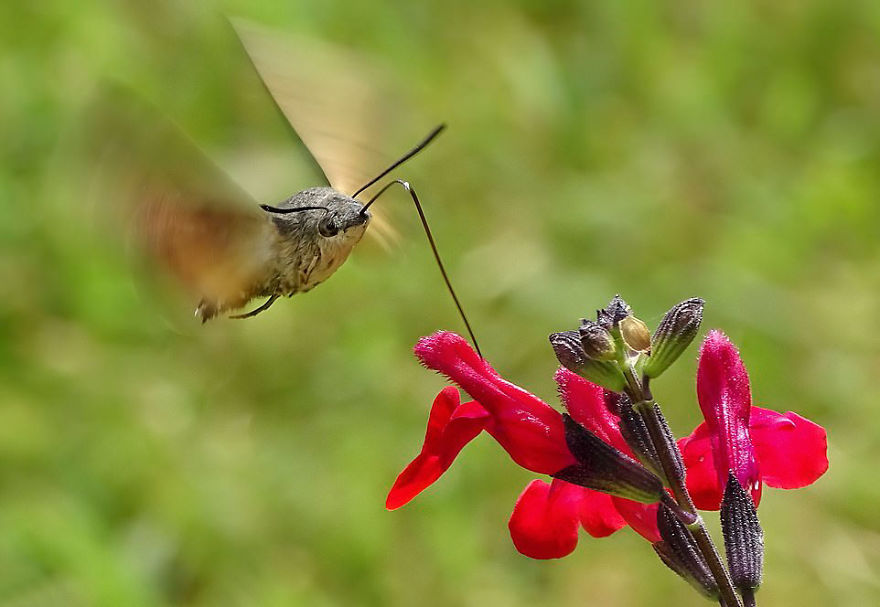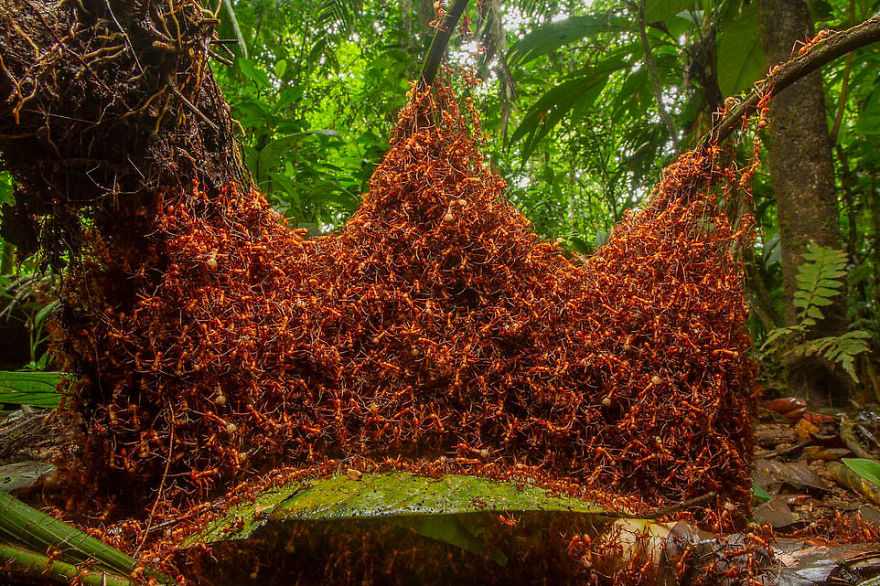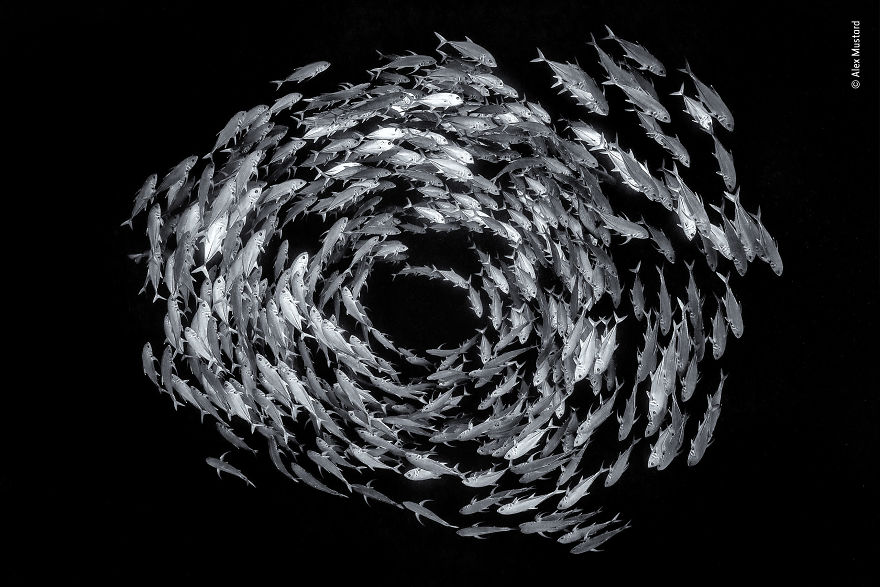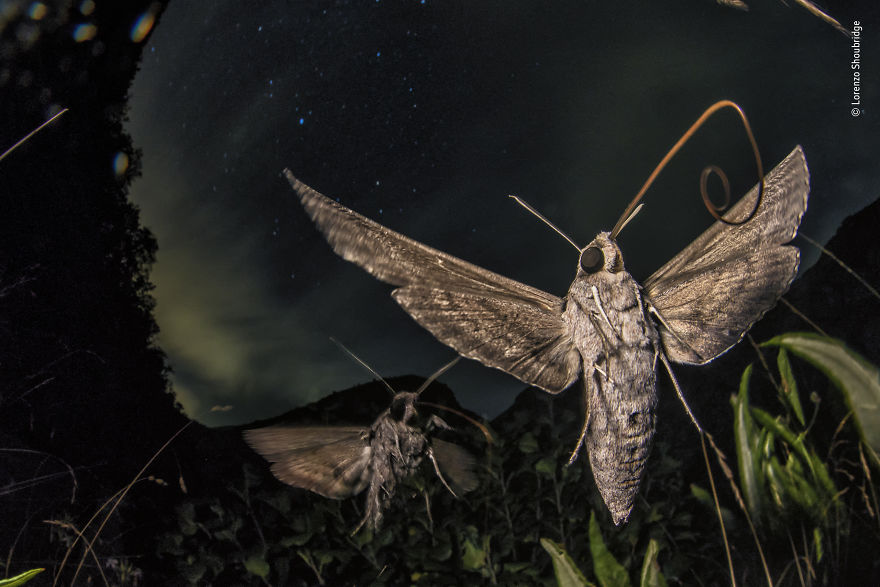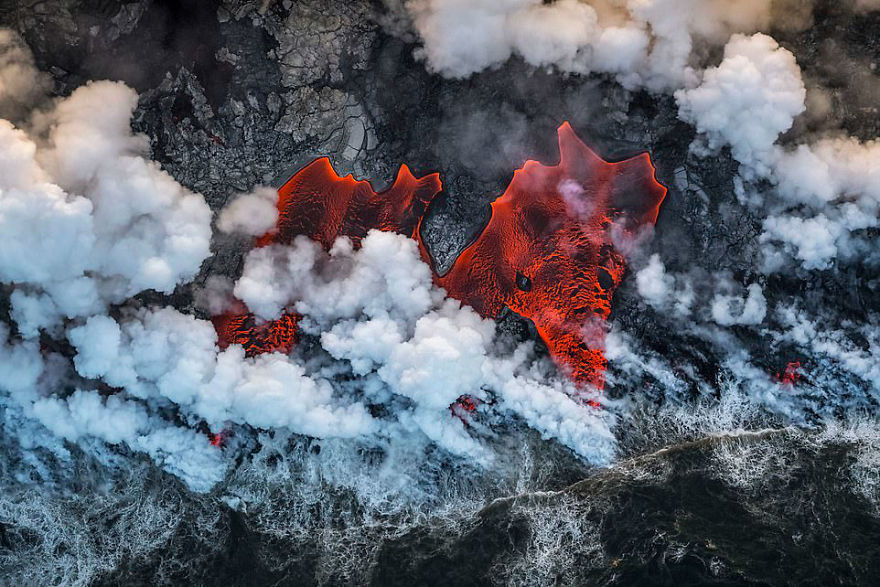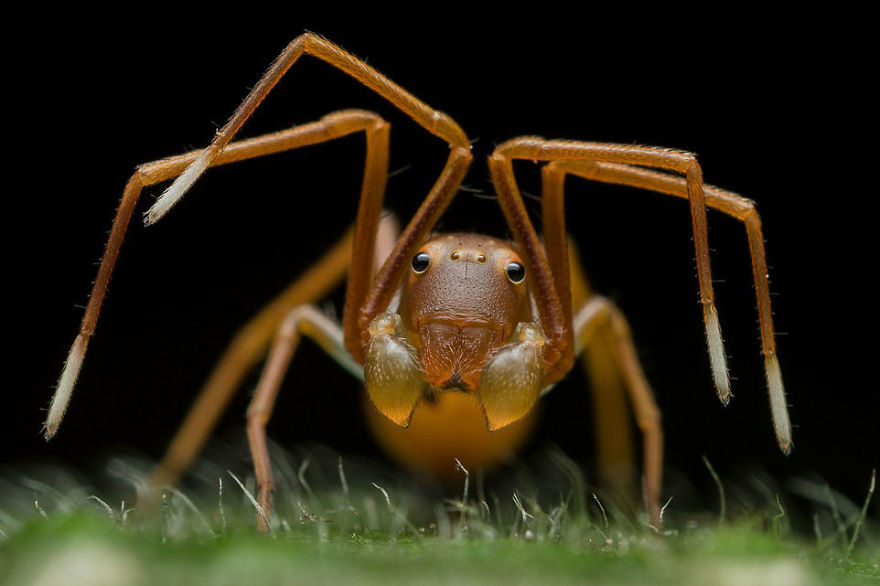Every year, we eagerly wait to see the fantastic photos that battle it out for fame, glory, and the chance to win their artists the honor of being called the Wildlife Photographer of the Year. This year’s winner is none other than Yongqing Bao, who won the award with his stunning photo called ‘The Moment,’ featuring a young fox and a marmot.
Scroll down, upvote your favorite photos, and share them with your friends. Let us know in the comments which pictures you like the best and why, as well as what you think of Bao's winning entry.
We love wildlife pictures, so be sure to check out Bored Panda’s recent article about (and interview with) photographer Gren Sowerby and his amazing shots of a lion yawning, smiling, and winking.
This post may include affiliate links.
"The Moment" By Yongqing Bao, China, Behaviour: Mammals, Grand Title Winner
This Himalayan marmot was not long out of hibernation when it was surprised by a mother Tibetan fox with three hungry cubs to feed. With lightning-fast reactions, Yongqing captured the attack – the power of the predator baring her teeth, the terror of her prey, the intensity of life and death written on their faces.
As one of the highest-altitude-dwelling mammals, the Himalayan marmot relies on its thick fur for survival through the extreme cold. In the heart of winter it spends more than six months in an exceptionally deep burrow with the rest of its colony. Marmots usually do not resurface until spring, an opportunity not to be missed by hungry predators.
"Bee Line" By Frank Deschandol, France, Behaviour: Invertebrates, Highly Commended 2019
Bees buzzed in the long grass around the lake as evening fell. To Frank’s delight, they were settling down in little rows along the stems. These were solitary bees, probably males, gathering for the night in suitable resting places, while the females occupied nests they had built nearby.
Being cold-blooded, bees gain energy from the sun’s heat and rest at night and during cool weather. Holding tight to the stems with their strong, jaw-like mandibles, they gradually relax – their bodies lower, their wings rest and their antennae droop – until they fall asleep, waiting for the morning to come.
"Land Of The Eagle" By Audun Rikardsen, Norway, Behaviour: Birds, Winner 2019
Audun carefully positioned this tree branch, hoping it would make a perfect lookout for a golden eagle. He set up a camera trap and occasionally left road-kill carrion nearby. Very gradually, over the next three years, this eagle started to use the branch to survey its coastal realm. Audun captured its power as it came in to land, talons outstretched.
Golden eagles typically fly at around 50 kilometres per hour but can reach speeds of up to 320 kilometres per hour when diving for prey. This, along with their sharp talons, makes them formidable hunters. Normally they kill small mammals, birds, reptiles or fish, but they also eat carrion and have been known to target larger animals too.
Chinese photographer Bao who won the award given out by London’s Natural History Museum captured the impressive moment when a fox attacked a marmot in the wild. In the photo, the marmot looks completely terrified of its attacker. The fear looks absolutely genuine and I think that most of us can sympathize with the poor animal whose life is in danger.
"Lucky Break" By Jason Bantle, Canada, Urban Wildlife, Highly Commended 2019
A raccoon poked her head out of an abandoned car and paused to assess her surroundings, allowing Jason just enough time to use a long exposure in the twilight. The back seat was an ideal den for the raccoon and her five cubs as the only entrance – through a blunt-edged hole in the glass – was large enough for her but too small for predators such as coyotes.
Raccoons tend to make their dens in hollow trees or rock crevices but they are extremely adaptable. Emerging at dusk, this mother will spend the night foraging for food for herself and her young. Raccoons are opportunistic and will eat anything from fruit and nuts to the contents of rubbish bins.
"Portrait Of A Mother" By Ingo Arndt, Germany, Animal Portraits, Highly Commended 2019
When you are eye to eye with a wild puma,’ says Ingo, ‘excitement is guaranteed.’ Tracking these elusive cats on foot meant lugging heavy gear long distances, often in freezing temperatures and unrelenting winds. Mutual respect gradually earned him the trust of a female and her cubs, allowing him to capture this intimate family portrait.
Pumas remain playful throughout their lives. Play-fighting teaches cubs vital survival skills including how to hunt, fight and escape. The cubs will stay with their mother for up to two years before gaining independence. They will live a solitary existence as adults until it is their turn to breed.
"Cool Drink" By Diana Rebman, USA, Behaviour: Birds, Highly Commended 2019
Despite the bitterly cold temperature of minus 20 degrees Celsius, Diana spent hours mesmerised by what she described as the ‘well-choreographed dance’ of a group of long-tailed tits taking turns to peck at an icicle. With the fast movement of the birds and her fingers feeling like blocks of ice, capturing their behaviour was no easy task.
Long-tailed tits live across Europe and Asia. Those living in Hokkaido, Japan, are referred to locally as Shima-Enaga. Winters there are cold and snowy and the birds must nibble on snow and ice for water. They spend their days foraging for insects and spiders and their nights huddled together in small groups for warmth.
‘The Moment’ was taken 14,800 feet (that’s 4.5 kilometers) above sea level, in the meadows of the Tibetan Plateau, in China. This area is also known as ‘The Roof of the World.’
"Snow Landing" By Jérémie Villet, France, Rising Star Portfolio Award, Winner 2019
With outstretched wings and intense eyes fixed on its prey, a bald eagle lands in fresh snow on a riverbank. Jérémie spent a week observing the behaviour of these birds from his hide. Spotting this one swooping down to catch salmon from the icy water below, he was well-positioned to capture this portrait.
To complete their life cycle, salmon return to their river of origin to spawn, dying shortly afterwards. An overabundance of dying salmon makes for easy meals for opportunistic eagles. Every year around 3,000 bald eagles gather at the Chilkat River in Alaska to feast on salmon.
"Snow Exposure" By Max Waugh, USA, Black And White, Winner 2019
In a winter whiteout a lone American bison briefly lifts its head from its endless foraging. Max purposefully slowed his shutter speed to blur the snow and ‘paint lines across the silhouette of the bison’. Slightly overexposing the shot and converting it to black and white accentuated the simplicity of the wintry scene.
Swinging their huge heads from side to side, American bison sweep away snow with their muzzles to eat the grasses and sedges buried beneath. Originally a common sight, their largescale slaughter for meat and hides brought them close to extinction in the nineteenth century. But populations are recovering and wild American bison now thrive in national parks.
"Cradle Of Life" By Stefan Christmann, Germany, Wildlife Photographer Portfolio Award, Winner 2019
It was easy to spot an emperor penguin with a hatching egg, says Stefan, because the father would frequently lift up his brood pouch to check on the chick’s progress. The problem was finding a bird facing the right direction at the crucial moment in the few minutes of good light available each day.
While his partner is away hunting at sea, the male endures the bitter Antarctic winter, without feeding, as he incubates their single egg. After a gruelling 65 to 75 days, the egg begins to hatch. Stefan watched the tiny chick struggle to crack the shell. ‘It kept closing its eyes and looked exhausted,’ he says.
The chair of the judging panel, Roz Kidman Cox, stated in a press release that photos from the Tibetan Plateau “are rare enough.” She added: “But to have captured such a powerful interaction between a Tibetan fox and a marmot—two species key to the ecology of this high-grassland region—is extraordinary.”
"Sky Hole" By Sven Začek, Estonia, Earth’s Environments, Highly Commended 2019
Positioning his drone directly above the small lake, Sven waited for the sun to emerge from behind the clouds to capture the reflection of the sky in the lake’s mirrored surface. Contending with technical issues and battery-power shortage, his patience was rewarded by this image of ‘an aerial view that looks like an eye’.
Karula National Park in Estonia is home to goshawks, lynx, wolves and bears. The ghostly outline of dead trees surrounding this lake is a telltale sign of the thriving population of beavers inhabiting Karula. Their naturally prolific dam-building causes higher-than-usual water levels that flood the forest floor, rotting the roots of any trees growing close to the shoreline.
"If Penguins Could Fly" By Eduardo Del Álamo, Spain, Behaviour: Mammals, Highly Commended 2019
A gentoo penguin flees for its life as a leopard seal bursts out of the water. Eduardo was expecting it. He had noticed the penguin resting on a fragment of broken ice and watched the seal swim back and forth. ‘Moments later, the seal flew out of the water, mouth open,’ he says.
Leopard seals are formidable predators. Their slender bodies are built for speed and their wide jaws bear long canine teeth. They hunt almost anything, changing their diet in response to availability and the time of year. Penguins are a regular meal but they also enjoy krill, fish, squid and the pups of other seal species.
"The Huddle" By Stefan Christmann, Germany, Wildlife Photographer Portfolio Award, Winner 2019
More than 5,000 male emperor penguins huddle on the sea ice, backs to the wind, heads down, sharing body heat. ‘It was a calm day,’ says Stefan, ‘but when I took off my gloves to focus the lens, the cold felt like needles piercing my fingertips.’ Antarctic winters are fierce, with temperatures below minus 40 degrees Celsius.
While the females spend two months at sea feeding, their mates care for the eggs. The male balances his precious cargo on his feet, tucked beneath a fold of skin called the brood pouch. Penguins on the windward edge of the huddle regularly peel off and join the more sheltered side, creating a constant rotation through the warm centre. Survival depends on cooperation.
Bao’s photo wasn’t the only one of note, however. For example, 14-year-old Cruz Erdmann was awarded the Young Wildlife Photographer of the Year for his photo of a bigfin reef squid that he captured while diving at night in the Lembeh Strait, near Indonesia.
"Frozen Moment" By Jérémie Villet, France, Rising Star Portfolio Award, Winner 2019
Entwined in each other’s thick spiral horns, two male Dall sheep pause during a fierce clash. For years, Jérémie had dreamed of photographing pure-white Dall sheep against a snow-clad alpine backdrop. Lying in the snow nearby, he battled with strong winds, heavy snow and bitterly cold temperatures, determined to capture this moment of both ‘purity and power’.
Dall sheep thrive in arctic and subarctic regions of the world. They depend on steep, rugged cliffs and outcrops to provide them with places to escape from predators, while using nearby open grass and meadows to feed. In winter they favour areas with strong winds that remove snow and expose forage.
"The Garden Of Eels" By David Doubilet, USA, Under Water, Winner 2019
A swaying colony of garden eels vanished into their burrows as soon as David arrived at this underwater scene. So as not to disturb them again, he set up his camera and hid behind a shipwreck where he could trigger the system remotely. It was several hours before the eels re-emerged and several days before David got his perfect shot.
The eels were feeding on plankton drifting in the current and were undisturbed by a wrasse and a cornetfish swimming by. If threatened, garden eels retreat into their burrows. Like many other fish, they detect movement through their lateral line, a sensory organ that runs the length of their bodies.
"Big Cat And Dog Spat" By Peter Haygarth, UK, Behaviour: Mammals, Highly Commended 2019
In a rare encounter, a lone male cheetah is set upon by a pack of African wild dogs. At first the dogs were wary, but as the rest of their 12-strong pack arrived their confidence grew. They began to encircle and probe the big cat, chirping with excitement. It was all over a few minutes later, when the cheetah fled.
Both cheetahs and African wild dogs have disappeared from large parts of their former territories, with fewer than 7,000 individuals left of each. Threatened by habitat loss, they exist at very low population densities. Pack sizes of African wild dogs have sharply declined from being as many as a hundred members strong to as few as seven to 15 individuals.
The photography competition has been going on for 55 years now and, this year, received over 48,000 entries from photographers hailing from 100 countries around the world.
"The Challenge" By Françoise Gervais, Canada, Animals In Their Environment, Highly Commended 2019
This polar bear appears tiny as it scales a steep scree slope. Steadying herself in a boat a few hundred metres from the shore, Françoise captured this image which she says shows how ‘even one of the most impressive predators can look insignificant and vulnerable in the immensity and inhospitality of this landscape’.
Climate change has reduced the expanse of sea ice from which polar bears usually hunt seals. Baffin Island polar bears now spend an extra 20 to 30 days a year on land compared to in the 1990s. Adapting to spending more time on land means expanding their diet. Some bears have been spotted scrambling on cliffs to reach birds and their eggs.
"Snow-Plateau Nomads" By Shangzhen Fan, China, Animals In Their Environment, Winner 2019
A small herd of male chirus makes its way to the relative warmth of the Kumukuli Desert. These nimble antelopes are high-altitude specialists found only on the Qinghai–Tibet Plateau. For years, Shangzhen made the long, arduous journey to observe them there. Here he drew the contrasting elements of snow and sand together.
Underneath their long hair, chirus have a light, warm underfur called shahtoosh. It grows tightly against their skin and can only be harvested by killing and skinning the chirus. Protection since the 1990s has seen their once-decimated numbers increase, but there is still demand – primarily from Westerners – for shahtoosh shawls.
"Night Glow" By Cruz Erdmann, New Zealand, 11-14 Years Old, Grand Title Winner
Cruz was on a night dive with his dad when he saw a pair of bigfin reef squid in the shallow water. One swam off but Cruz quickly adjusted his camera and strobe settings, knowing that the opportunity was too good to miss. He shot four frames of the remaining squid before it too disappeared into the inky blackness.
Bigfin reef squid are masters of camouflage, changing their body colour and pattern using their reflective and pigmented skin cells. They also alter their appearance to help them communicate. During courtship, males and females display complex patterns to indicate their willingness to mate.
"The Rat Pack" By Charlie Hamilton James, UK, Urban Wildlife, Winner 2019
On Pearl Street in Lower Manhattan, brown rats scamper between their home under a tree grille and a pile of rubbish bags full of food waste. Lighting his shot to blend with the glow of the street lights and operating his kit remotely, Charlie captured this intimate, street-level view.
Urban rat populations are rising fast worldwide and their association with spreading disease in humans inspires fear and disgust. Rats are smart and capable of navigating complex networks such as subway systems. Being powerful swimmers, burrowers and jumpers makes these rodents particularly well suited to city living.
"The Albatross Cave" By Thomas P Peschak, Germany/South Africa, Animals In Their Environment, Highly Commended 2019
The large cave on the side of Te Tara Koi Koia shelters the eggs and chicks of Chatham albatrosses until the young are ready to fly. The island is the only place in the world where they breed naturally, making Thomas one of the privileged few to have witnessed and captured this moment.
Having a single breeding ground means that the future of Chatham albatrosses is insecure. Since the 1980s extreme storms have eroded the soil on Te Tara Koi Koia and destroyed vegetation crucial to nest-building. Conservationists recently translocated a new breeding colony onto the largest of the Chatham Islands to improve their chance of survival.
"Pondworld" By Manuel Plaickner, Italy, Behaviour: Amphibians And Reptiles, Winner 2019
Every spring for more than a decade, Manuel followed the mass migration of common frogs. He took this image by immersing himself and his camera in a large pond where hundreds of frogs had gathered. There he waited until the moment arrived for the picture he had in mind – lingering frogs, harmonious colours, soft, natural light and dreamy reflections.
Rising spring temperatures bring common frogs out of their winter shelters. They head straight to water to breed, often returning to where they were spawned. Though widespread across Europe, their numbers are thought to be declining due to habitat degradation from pollution and drainage of breeding sites.
This looks like a psychedelic trip after licking a frog. This is really neat looking
"Humming Surprise" By Thomas Easterbrook, UK, 10 Years And Under, Winner 2019
A curious sound drew Thomas to this hummingbird hawkmoth. He watched as it hovered in front of each salvia flower and drank the nectar using its long, straw-like proboscis. Framing the fast-moving insect was challenging, but Thomas was pleased with how he captured the stillness of the moth’s body and the blur of its wings.
Hummingbird hawkmoths are unusual in that they fly by day, so their eyesight is better than most other moths’. In flight they look so similar to hummingbirds that they can be easily confused. This similarity inspired their name, as did the hum created by their wings beating around 85 times each second.
But still even a camera on 1/4000 of a sec. can't capture the movement of their wings.
"The Equal Match" By Ingo Arndt, Germany, Behaviour: Mammals, Joint Winner 2019
The guanaco turns, terrified, his last mouthful of grass flying in the wind as a female puma attacks. For Ingo, this is the culmination of months of work tracking wild pumas on foot, enduring extreme cold and biting winds. After an intense four-second struggle, the guanaco escaped with his life, leaving the puma to go hungry.
Because they are so abundant in Patagonia, guanacos are common prey of pumas. These big cats are solitary and hunt by patiently stalking before they pounce. Their robust hind legs allow them to take on animals bigger than themselves but they can also feed on smaller animals, such as rodents and birds.
"The Ethereal Drifter" By Angel Fitor, Spain, Under Water, Highly Commended 2019
Stretching out its sail-like lobes to ride the Mediterranean currents, this delicate comb jelly is trawling for food. This was a rare sight. The species is normally found with its fragile sails folded or damaged. Angel approached his subject extremely carefully. Describing it as a ‘glass butterfly’, Angel saw that ‘it folded its sails at the slightest vibration’.
This comb jelly steers itself through the water using beating rows of hair-like cilia which form combs along its cylindrical body. The combs scatter light, creating colourful iridescence. Unlike jellyfish, comb jellies do not sting. Instead they catch plankton and other small prey using sticky cells in their lobes and tentacles.
"The Architectural Army" By Daniel Kronauer, Germany/USA, Behaviour: Invertebrates, Winner 2019
By day this colony of army ants raided their surrounds, mostly hunting other ant species. At dusk they moved on, travelling up to 400 metres before building a nest for the night. Positioning his camera on the forest floor, Daniel was wary of upsetting thousands of venomous army ants. ‘You mustn’t breathe in their direction,’ he says.
Army ants alternate between nomadic and stationary phases. These ants are in a nomadic phase, building a new nest each night using their own bodies. The soldier ants interlock their claws to form a scaffold while the queen stays inside in a network of chambers and tunnels. During the stationary phase they will stay in the same nest while the queen lays new eggs.
"Circle Of Life" By Alex Mustard, UK, Black And White, Highly Commended 2019
In the crystal-clear waters of the Red Sea a school of bigeye trevally formed a circular shoal a few metres from Alexander’s lens. For 20 years Alexander had been coming to photograph the summer spawning of reef fish. ‘A big lure that sees me return each year is that I always see something new,’ he says.
The spawning population of bigeye trevally is boosted by the protected status of Ras Mohammed National Park as a no-fishing marine reserve. Adult bigeye trevallies are vulnerable to attack from larger fish. During the spawning season they school both to protect themselves and to increase the likelihood of contact between eggs and sperm.
"Migrant Megamoths" By Lorenzo Shoubridge, Italy, Behaviour: Invertebrates, Highly Commended 2019
Lorenzo was intrigued to see convolvulus hawkmoths flying back and forth, looking for food. He tracked the moths over several evenings, dulling his torch with a cloth in order not to disturb them and keeping to the road to avoid trampling the vegetation. After many attempts, he finally captured the feeding forays of these two individuals.
Moths often travel very long distances in search of food and suitable environments in which to lay their eggs. In the Apuan Alps the landscape is fast-changing. The extraction of marble from the mountains creates significant air and water pollution, threatening the region’s biodiversity and reducing the moths’ natural habitat.
Excuse me, but do you have a moment to talk about our savior, Lamp?
"Creation" By Luis Vilariño, Spain, Earth’s Environments, Winner 2019
Red-hot lava from Kīlauea volcano instantly boils the cool Pacific Ocean where they meet at the Hawaiian coast. As Luis’s helicopter flew along the coastline a sudden change in wind direction parted the plumes of steam to reveal the fiery river. Quickly framing his shot through the helicopter’s open door, he captured the tumultuous creation of new land.
As the lava boils the seawater, it produces acid steam and tiny shards of glass, which combine to create a lava haze or ‘laze’. This eruption was Kīlauea’s largest in 200 years. For three months in 2018, lava spewed from the summit and surrounding fissures, eventually destroying over 700 homes and solidifying to create hundreds of acres of new land.
"Face Of Deception" By Ripan Biswas, India, Animal Portraits, Winner 2019
Ripan was photographing a red weaver ant colony when he spotted this slightly strange individual. It may have the face of an ant but its eight legs give it away – on closer inspection Ripan discovered that it was an ant-mimicking crab spider. By reverse mounting his lens, Ripan converted it to a macro capable of taking extreme close-ups.
Many spider species imitate ants in appearance and behaviour. Infiltrating an ant colony can help them prey on unsuspecting ants or avoid being eaten by predators that dislike ants. This particular spider, says Ripan, seemed to be roaming around the colony, looking for a solitary ant that it could grab for a meal.
"The Hair-Net Cocoon" By Minghui Yuan, China, Behaviour: Invertebrates, Highly Commended 2019
With his face pressed against a wall, Minghui framed this Cyana moth pupa hanging in its remarkable cage-like cocoon. Such delicate structures can be hard to spot but this one stood out against its backdrop in the Xishuangbanna Tropical Botanical Garden.
Although it is not known exactly how the caterpillar architect of this cocoon would have worked, it is known that it wove this intricate mesh from spat-out silk and from the long, hair-like setae that covered its body. It then spun near-invisible threads to suspend itself inside the cocoon, ready to start its transformation into a moth.
Insects are very interesting. And mammals, and birds, and reptiles, and amphibians, and fish.
"Couch Crew" By Cyril Ruoso, France, Urban Wildlife, Highly Commended 2019
In a disused temple in Hua Hin, young long-tailed macaques relax on a sofa tattered from their playtime antics. Cyril framed a group that had positioned themselves ‘like band members posing for an album cover’, while others leapt back and forth between a statue, his rucksack and even the top of his head.
Long-tailed macaques are very adaptable, thriving in a range of habitats including living alongside humans. In Thailand people have a complex relationship with the monkeys. The macaques are tolerated and sometimes even venerated near temples. At the same time, when they damage farms and property they are regarded as pests.
"Early Riser" By Riccardo Marchegiani, Italy, 15-17 Years Old, Winner 2019
Riccardo could not believe his luck when this female gelada walked along the cliff edge where he had been waiting since before sunrise. Keeping a respectful distance, Riccardo composed his shot using a low flash to highlight the gelada’s light brown fur against the distant mountains. The beam also caught the eye of the inquisitive infant clinging to her belly.
A baby gelada will spend the first few weeks of its life being carried around on its mother’s front before moving to her back. Geladas live on the ground and drop down onto ledges in cliff faces for safety when they sleep. Farmland is encroaching on their native grasslands and their habitat is shrinking.
"Tapestry Of Life" By Zorica Kovacevic, Serbia/USA, Plants And Fungi, Winner 2019
Festooned with bulging orange velvet and trimmed with grey lace, the arms of a Monterey cypress tree twist to create an otherworldly canopy. After several days experimenting, Zorica decided on a close-up frame. She focus-stacked 22 images, merging the sharp features in each of the photographs to reveal the colourful maze in depth.
Point Lobos State Natural Reserve in California is the only place in the world where natural conditions combine to conjure this magical scene. The spongy orange cladding on the Monterey cypress is in fact an alga that gets its colour from beta-carotene, the same pigment that is in carrots. Both the orange alga and the grey lace lichen are harmless to the cypress.
"Another Barred Migrant" By Alejandro Prieto, Mexico, Wildlife Photojournalism, Winner 2019
It took Alejandro two years to take the perfect photo of a male jaguar. Under a luminous, star-studded Arizona sky, he projects it onto a section of the US–Mexico border fence to symbolise ‘the jaguar’s past and its possible future presence in the United States. If the wall is built,’ he says, ‘it will destroy the jaguar population in the United States.’
Jaguars are mainly found in South America but historically also roamed the southwest of the United States. Over the past century, hunting and habitat destruction have resulted in the species disappearing from this area. Any hope of establishing a breeding population in this region rests on the contentious border remaining partially open.
"Last Gasp" By Adrian Hirschi, Switzerland, Behaviour: Mammals, Highly Commended 2019
A newborn hippo, just days old, was keeping close to its mother when a large bull hippo suddenly made a beeline for them. He chased the mother away and went after the calf, seizing it violently in his huge gape, clearly intent on killing it. ‘All the while, the distraught mother looked on helplessly,’ says Adrian.
Infanticide among hippos is rare but not unknown. It usually occurs when hippos travel beyond their territory and mix with new groups. By killing the young that are not his, it is believed that a male can increase his reproductive success by bringing females into oestrus, ready to mate with him.
I understand nature isn't always kind, but I hate to see these animals in the moments before they are killed &/or eaten. Not a good way to start the day.
Yeah. The hippo-baby made me sick. I shouldn't have klicked on it. At least, there was a warning
Load More Replies...I understand nature isn't always kind, but I hate to see these animals in the moments before they are killed &/or eaten. Not a good way to start the day.
Yeah. The hippo-baby made me sick. I shouldn't have klicked on it. At least, there was a warning
Load More Replies...
 Dark Mode
Dark Mode 

 No fees, cancel anytime
No fees, cancel anytime 











